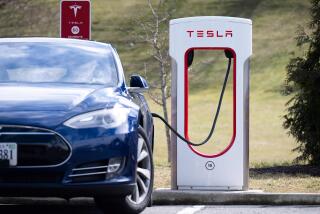Bigger Load on Modern Batteries
- Share via
Question: In the country where I come from, car batteries develop difficulty cranking the engine as they get older and then finally give up. During the six years I have been here, two of my new maintenance-free batteries have gone dead without any warning. It seems to be the same with my friends. What causes batteries to fail that way?
H.A.S.
Answer: You are correct that batteries fail either catastrophically when they suddenly lose all their capacity or degrade slowly over time. Modern battery design does not necessarily lead to one type of failure more than another. But batteries today are required to do far more work than in past years and that can lead to all types of failures.
New cars carry far more electrical systems, including power windows, defoggers, car seat heaters, door locks, dashboard instruments and high-power sound systems. In many cases, cars carry so many electrically powered gadgets that the charging system is unable to supply all the electrical current needed by the car during idle. So, the battery must temporarily drain.
In addition to the electrical devices that the driver controls, cars are carrying increasing numbers of electronic computer controls that require a constant source of power, known among engineers as parasitic loads. In technical terms, these parasitic loads impose a 20- to 30-milliampere drain on a battery around the clock, meaning that a battery drains slowly when the car is not in use.
Another factor that puts batteries under increasing stress is the higher temperatures being reached in the engine compartments of newer cars. The engine areas are more cramped and engines themselves run at higher temperatures. High heat kills batteries.
The high electrical loads created by new cars cause batteries to drain further before they can be recharged by the car. The deeper a battery is cycled in such situations, the faster it will wear out.
A battery should last between five and 10 years, but it depends on variables such as how the car is driven and how many electrical bells and whistles the car carries. A car driven on short trips in a very hot climate will subject a battery to the maximum of stress.
A 12-volt car battery is made up of six cells, each of which produces about two volts. Each cell has positive plates made of lead oxide and negative plates made of a spongy lead. The plates are bathed in a solution of diluted sulfuric acid. The acid combines with the lead oxide to form lead sulfate and produces electrical current. When the battery is charged, the process is reversed.
A battery begins to lose it ability to hold a charge as its grids corrode or as material sheds from the grids. New maintenance-free batteries also can lose electrolyte, which can not be replenished with water, because the battery cells are sealed at the factory.
These factors can often hasten a catastrophic failure of a battery. When a battery fails catastrophically, it is generally caused by either an open or a short circuit.
Some open or short circuits are caused by defects, such as the breaking of an internal weld. But others can be related to a battery’s aged condition. For example, a short can result from the loss of a separator plate between the grids or separated grids. Material can bridge the gap between grids. Since these failures can not be repaired, it means buying a new battery.





